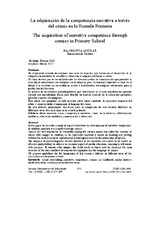Mostrar el registro sencillo del ítem
La adquisición de la competencia narrativa a través del cómic en la escuela primaria
| dc.contributor.author | Segovia Aguilar, Blas | |
| dc.date.accessioned | 2012-11-20T13:01:12Z | |
| dc.date.available | 2012-11-20T13:01:12Z | |
| dc.date.issued | 2012-11-10 | |
| dc.identifier.issn | 1130-2496 | |
| dc.identifier.uri | http://hdl.handle.net/10396/8252 | |
| dc.description.abstract | En el presente artículo describimos una serie de aspectos que favorecen el desarrollo de la competencia narrativa de los niños y cómo ésta se adquiere mediante el cómic. El cómic destaca por su versatilidad entre los diversos medios de comunicación que permiten la creación de narraciones con imágenes en la infancia, pues su material expresivo se basa en el dibujo y la escritura sin necesidad de acudir a instrumentos tecnológicos sofisticados para la producción del discurso. El análisis de los factores psicolingüísticos que intervienen en el acto narrativo nos permite esbozar una metodología eficaz para abordar un aspecto esencial de la educación mediática: aprender a narrar con imágenes. Para narrar con imágenes, el niño necesita saber cómo construir la estructura temporal del relato y como trasladar el argumento al lenguaje del cómic. En este trabajo, proponemos directrices para la integración de este recurso didáctico en diferentes áreas del curriculum en la escuela primaria. Palabras clave: narrativa visual, competencia narrativa, cómic en la infancia, alfabetización mediática, educación mediática, comunicación y educación. | es_ES |
| dc.description.abstract | In this paper we describe a range of aspects that favor the development of narrative competence of children, and how it is acquired through comics. Comics are well known for its versatility among the various media that allow the creation of stories with images in children, as its expressive material is based on drawing and writing without the need to resort to sophisticated technological tools for the production of speech. The analysis of psycholinguistic factors involved in the narrative act allows us to sketch an effective methodology to address an essential aspect of media education: learning to tell stories with pictures. To narrate with images, the child needs to know how to construct the term structure of the story and how to translate the argument into the language of comics. We propose guidelines for the integration of this resource didactic in different areas of the curriculum in elementary school | es_ES |
| dc.format.mimetype | application/pdf | es_ES |
| dc.language.iso | spa | es_ES |
| dc.publisher | Universidad Complutense de Madrid | es_ES |
| dc.rights | https://creativecommons.org/licenses/by-nc-nd/4.0/ | es_ES |
| dc.source | Revista Complutense de Educación 23 (2), 375-399 (2012) | es_ES |
| dc.subject | Narrativa visual | es_ES |
| dc.subject | Competencia narrativa | es_ES |
| dc.subject | Educación mediática | es_ES |
| dc.subject | Educomunicación | es_ES |
| dc.subject | Visual storytelling | es_ES |
| dc.subject | Narrative competence | es_ES |
| dc.subject | Comics in childhood | es_ES |
| dc.subject | Communication and education | es_ES |
| dc.title | La adquisición de la competencia narrativa a través del cómic en la escuela primaria | es_ES |
| dc.title.alternative | The acquisition of narrative competence through comics in Primary School | es_ES |
| dc.type | info:eu-repo/semantics/article | es_ES |
| dc.rights.accessRights | info:eu-repo/semantics/openAccess | es_ES |

